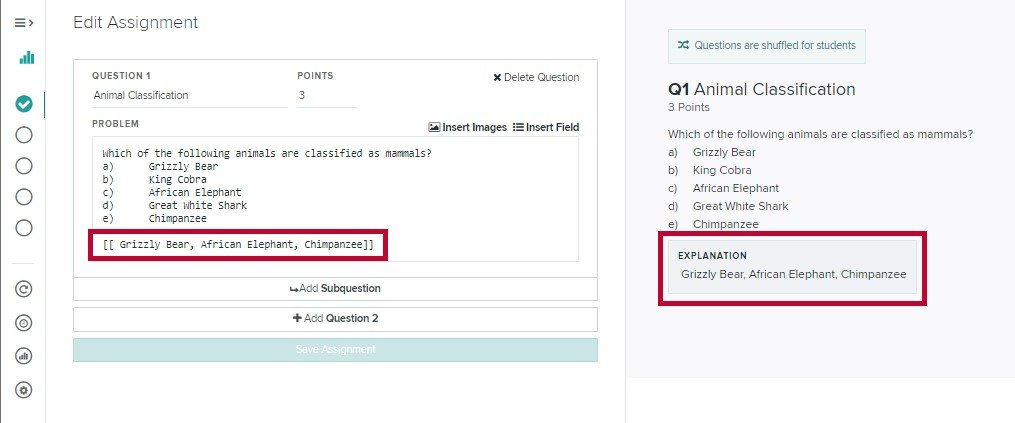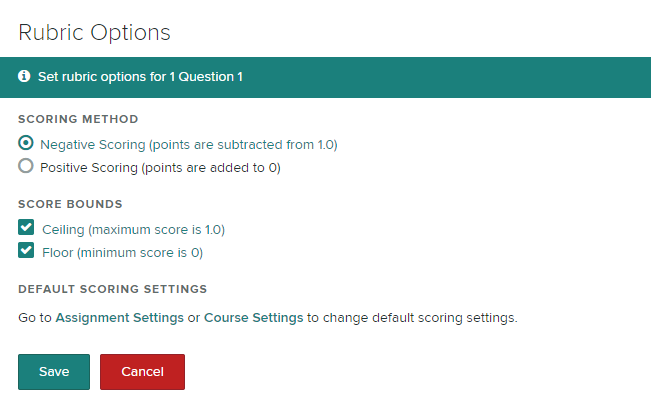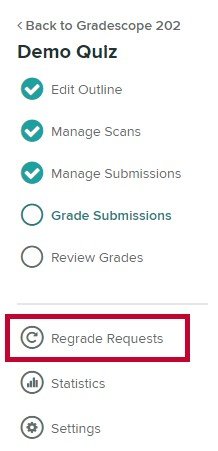About Gradescope Online Assignments
Gradescope Online Assignments allow instructors to create an assignment directly on Gradescope (no uploads required). Students record and submit responses on the Gradescope platform. While Online Assignments are similar to the CourseLink’s Quizzes tool, it includes the following unique features:
A single question can contain multiple field types (e.g., multiple choice, select all, short answer, free response, etc.),
Questions can also contain a series of sub-questions (e.g., Question 2 could include a statement, followed by a series of related questions: 2.1, 2.2, 2.3, etc.).
Any question type can include a file upload field, allowing students to submit an image of work completed on paper.
Instructors grade free response and file upload responses using Gradescope’s dynamic rubrics.
Assessment is streamlined for more efficient collaborative grading.
Students may request regrades for specific questions through the interface (optional feature).
When Should I Use Gradescope Online Assignments?
While Gradescope Online Assignments offers a variety of evaluation and feedback options, CourseLink Quizzes is a comparable tool with more advanced options for maintaining academic integrity. It is up to the individual instructor to decide which feature sets are most appropriate for their assessment needs.
The Gradescope Online Assignment Process
Online assignments allows instructors to create questions directly on Gradescope. Students will be able to log in, access the assignment and submit responses. For some types of questions (multiple choice, select all, and short answer), you can also indicate the correct answer ahead of time, and student submissions will be automatically graded. The basic steps of the process creating an exam or quiz are outlined below:
Create an Online Assignment
Instructors have two options to access Gradescope Online Assignment’s – via CourseLink Integration (Content Tool) or directly through gradescope.ca using Single Sign On.
To get the most out of Gradescope and to ensure that your online assignment is synced with your CourseLink site’s Classlist and connected to a corresponding grade item, it is recommended that the assignment be created through the integration. Please view our resources for Gradescope’s CourseLink Integration to learn how to create your assignment.
Once the assignment is created via the integration, it can be accessed through the link created in your course site’s Content tool, or by logging in via SSO at gradescope.ca using the School Credentials option.
Settings Options for Online Assignments
When creating online assignments, you are required to:
Enter a name for your assignment
Set a Release Date (when it becomes available to students)
Set a Due Date (when submissions are expected by)
(Optional) enable Allow Late Submissions (when student may submit past the due date, but the submission will be flagged as late)
(Optional) enable Enforce time limit (set the amount of time students have to complete the assignment once started)
Choose when you will create your rubric(s) (before student submissions or while grading submissions).
Note: If you select before student submissions you may still modify the rubric while grading.
Create Outline (add questions)
The Outline of an Online Assignment is where questions are created. Unlike the CourseLink Quizzes tool, there is no import option for questions or a Question Library to pull questions from. All questions must be created directly in the Online Assignment’s Outline. That said, Online Assignments can be duplicated (copied) in the same course or to a new course.
Please visit the Gradescope Help Centre’s Adding Your Questions resource for detailed information.
Answer Input Fields
There are five answer input field types available in Gradescope: Multiple Choice, Select All, Short Answer, Free Response, and File Upload. Automatic grading is available for Multiple Choice, Select All, and Short Answer fields. However, Free Response and File Upload fields require manual grading using a Gradescope rubric.,
Questions in Online Assignments are not limited to a single answer input field or input field type. For example, the question below combines a select all field, a free response field, and a file upload filed in a single question:
Question 1 [15 points]:
(Select All Field) Which of the following animals are classified as mammals? [3 points]
[ ] Grizzly Bear
[ ] King Cobra
[ ] African Elephant
[ ] Great White Shark
[ ] Chimpanzee
(Free Response Field) Select one of the mammals you identified above, and indicate its (1) Kingdom; (2) Phylum or Division; (3) Class; (4) Order; (5) Family; (6) Genus; (7) Species. [7 Points]
(File Upload Field) Draw and label classification chart featuring the mammal selected above and a reptile of your choice and upload it. [5 points]
Please visit the Gradescope Help Centre’s Answer Input Fields resource for detailed information.
Adding Explanations
Instructors have the option to add explanations associated with correct answers.
You can add explanations for the correct answer and choose when/if you'd like students to see these explanations.
To add an explanation to a question, put two square brackets ([[ ]]) around the explanation text. Make sure to put the explanation on a separate line, with no text before or after it. For multiple-line explanations, use brackets around each line of the explanation. Empty lines between explanations will break them up into two separate blocks. There isn’t currently a way to provide explanations for incorrect answers. However, you can add details about incorrect answer options to the explanation for the correct answer.
To choose when/if students see an explanation depends on whether the two Answer Visibility boxes are checked on the assignment's Settings page.
To learn how to choose when/if to include these explanations, visit the Gradescope’s Help Centre’s Adding Explanations resource.
Adding Subquestions
Another unique feature of Online Assignments is the ability to create and add subquestions. Adding a subquestion turns the question into a question group and adds a child question of the current question. Subquestions can be a great way to group questions that are all related to the same scenario, data set, image, etc.
Please visit the Gradescope’s Help Centre’s Adding Subquestions resource for more information.
Student Submissions
Once the Online Assignment is created, any students on the Gradescope course’s roster will be able to access the assignment to make a submission as of the Student submissions of release date and time set.
Students can submit or update their answers as many times as they need to until the due date/late submission date has passed. Instructors and TAs will only see students’ final answers for each question.
The way students save or submit answers is slightly different based on whether or not the assignment has a time limit. In timed assignments, students’ answers will be autosaved as they enter them. However, in non-timed assignments, students will need to click the Submit Answer button as they finish each question.
Please visit the Gradescope’s Help Centre’s Submission Interface resource for more information.
Extending Dates and Times
If you would like to alter the release date, due date, or late due date for a specific student on a specific assignment, you may do so by accessing the assignment in Gradescope and selecting Extensions in the left menu.
More detailed information on this process can be found on the Gradescope Help Centre’s Extending assignment release dates, due dates, and time limits page.
Alternatively, you may apply time-limit extensions for specific students across all assignments in your Gradescope course. This can be helpful if you have multiple Gradescope assignments and students who have been granted time-and-a-half or double time extensions through Student Accessibility Services (SAS) . To provide extensions at the course level, return to your Gradescope course’s dashboard (click the course code on the left menu), then select Extensions from the left panel menu.
More detailed information on this process can be found on the Gradescope Help Centre’s Extending Time Limits at the Course Level page.
LockDown browser (beta)
LockDown Browser Powered by Respondus is available for timed online assignments. Please note that this is only LockDown Browser, not LockDown Browser + Monitor, which is available in the CourseLink Quizzes tool.
Enabling the LockDown Browser means that once students have started their timed Online Assignment, they will be taken to a secured browser window and will not be able to open any additional tabs, windows, or applications until they have finished their work. Students will only be able to submit once and will not be able to resubmit or update answers after turning in the assignment or the timer runs out.
Please note that this feature is in beta and not available on Gradescope courses by default. If you would like to enable the LockDown Browser option for your Gradescope course, please send a request to help@gradescope.ca and include a link to your Gradescope course (not your CourseLink course).
For more detailed information on LockDown Browser in Online Assignments, please visit the Gradescope Help Centre’s Additional security with LockDown Browser (Beta) resource.
Grade Submissions
Gradescope will auto-grade Multiple Choice, Select All, and Short Answer fields based on the correct answers indicated when they were added to questions in the outline. Please note that you can manually regrade auto-graded questions by going to the Grade Submissions page, clicking on the question name, and editing the rubric or rubric item applications.
Free Response and File Upload fields can only be graded manually using Gradescope Rubrics from the Grade Submissions page.
Please note that Gradescope’s AI-assisted grading, answer-grouping, and mark-up/annotation features are not available for any answer field in Online Assignments. For more detailed information, please visit the Gradescope Help Centre’s Grading resource for Online Assignments.
Review/Release Grades
Once you are finished grading submissions, the Review Grades page provides an overview of what was graded and allows you to:
Publish grades and feedback for student review
Includes an option to notify students via email that grades/feedback are available
Post grades from Gradescope to CourseLink via the integration
Export assignment grades, evaluations, and submissions
Note: If you do not want students to access the assignment template, grades, or feedback through Gradescope do not publish the grades in Gradescope. You can still use the Post Grades to CourseLink option to push the scores to the associated grade item via the integration, even if the grades are not published on Gradescope.
Hiding Questions and Responses
Instructors can choose to hide an Online Assignment’s questions and students’ responses after the time limit expires or the due date passes (if no time limit is set).
Step-by-step instructions can be found on the Gradescope Help Centre’s Hiding Questions and Responses resource.
Hiding Rubric Items
By default, all rubric items are shown to students. However, in some cases it may be preferable to hide all or part of the rubric from students. You can change this from the Assignment Settings page.
For more information on the options available for showing or hiding rubric items, please visit the Gradescope Help Centre’s Hide rubric items resource.
Displaying Answers Immediately
By default, students won’t see their feedback and scores until the Publish Grades button is pressed. However, for formative assessments you may want students to see their results and feedback for auto-graded questions immediately. This can be achieved by publishing grades before releasing the assignment to students.
More information on this process can be found on the Gradescope Help Centre’s Displaying Answers Immediately resource.
Displaying Answers After the Due Date
Instructors can allow students to see the correct answers for each auto-graded question (e.g., multiple-choice, select all, and short answer questions) after the due date has passed (even if they did not get the correct answer) once grades are published. To enable this feature, select the Show answers after due date box on the assignment’s Settings page.
For more information on the options available for showing or hiding rubric items, please visit the Gradescope Help Centre’s Hide rubric items resource.
REGRADE REQUESTS
Regrade requests allow students to submit short statements about why they think their work should be given another look.
Regrade requests are enabled by default for all published assignments. However, they can be disabled by following the steps below:
- Access the Regrade Requests feature from the lefthand toolbar.
- Here you can enable/disable the feature by clicking the Disable Regrade Requests.
Access Data and Statistics
Gradescope provides data and statistics for online assignments on two levels:
- Assignment Statistics: The default view showcases the averages from each question. Clicking a question’s bar within the chart will focus on it, updating the stats under the chart.
- Question Statistics: If you click a question in the table below the chart, you can see that question’s statistics, showing you how often each rubric item was applied. This allows you to pinpoint difficulties or concepts that students struggled with.
Useful Tips:
For timed online assignments, instructors may add an additional security measure - LockDown Browser.
Follow Gradescope’s recommendations for creating each type of question (e.g., multiple choice, short answer, etc.).
Related Videos
Related Programming
Gradescope Online Drop-ins (Tue. 10 AM / Wed. 2 PM)
Weekly Online Workshop: Get Started with Gradescope (Thu. 12 PM)
Introduction to Gradescope (03/03/2022)
Introduction to Gradescope Online Assignments (03/29/2022)
Other Gradescope Assignment Types
Other Gradescope Scenarios
Gradescope Support
Additional Support information for Gradescope can be found on our Gradescope Support page.
If you need further assistance, please contact CourseLink Support.






















